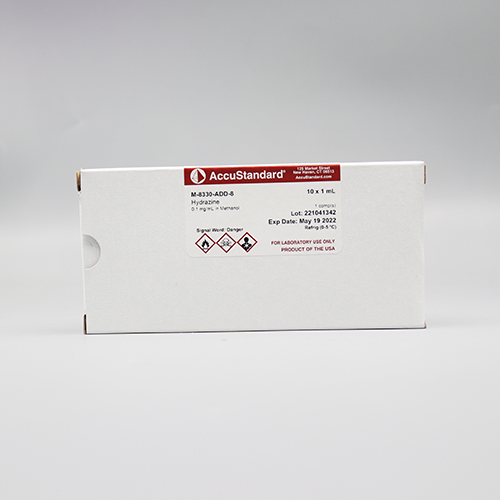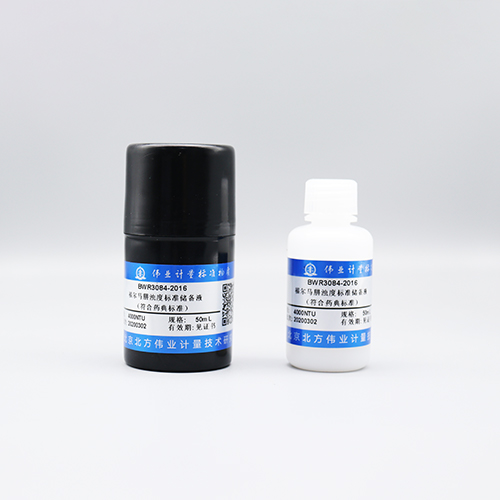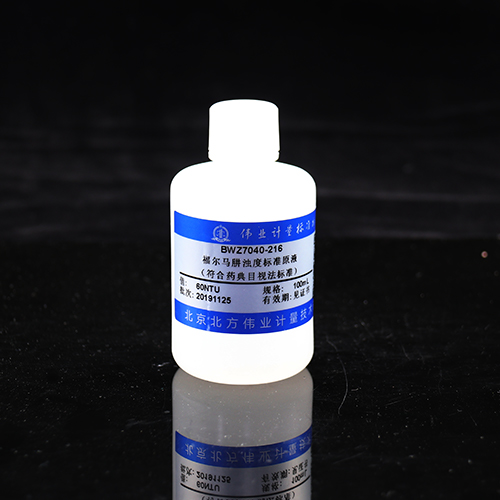标准物质一站式采购平台
- 产品
- 帖子
- 新闻
标准物质一站式采购平台

Hydrazine
Solvent:Methanol
Hazards:Refer to sDS for complete safety information
Sample Size: 1 mL
Components: 1
Storage Condition:Refrig (0-5 ℃)
| Component | CAS # | Purity % (GC/MS) |
Prepared Concentration2 (ug/mL) |
Certified Analyte Concentration1 (ug/mL) |
| Hydrazine | 302-01-2 | 100.0 | 100.8 | 100.8 |
1. Quality Standards:
IS0 17034 - General Requirements for the Competence of ReterenceMaterial Producers ANAB Certificate Number AR-1463
ISO/IEC 17025- General Requirements for the Competence of TestingAnd Calibration Laboratories ANAB Certificate Number AT-1339
ISO 9001:2015 - Quality Management System - RequirementsEagle Registrations Certificate Number 3774
2. Intended Use: The product covered by this certificate is designed for calibration or for use in quality control procedures
for the specified chemical compounds listed on the reverse side. This product can be used for quantification and/oridentification. This product can also be used as a reference material to validate analytical procedures, subject to theconditions under Section 7.
3. Manufacturing: All balances are calibrated daily using an in-house procedure with weights that are compared annually
to master weights and traceable to NIST.The balances are also calibrated annually by an ISO/IEC 17025 accreditedcalibration laboratory. Please refer to the NIST test number listed on the front of this certificate. Class A glasswareis used in the manufacture and quality control of all standards and calibrated using an in-house procedure. GoodLaboratory Practices have been used throughout the preparation of this Standard.
4. Homogeneity: This product is sufficiently homogeneous and any sample size would be within the uncertainty budget.
5. Stability: The manufacturer guarantees the stability of this solution through the expiration date stated on the label,
when handled and stored according to the conditions stated on the label
6. Uncertainty: The uncertainty values as stated on the face of this certificate have been determined using the
EURACHEM/CITAC Guide. We report a combined expanded uncertainty equal to the positive square root of the totalvariance of the uncertainty of the components using the following formula.This formula represents uncertainty components from the mass,volume, short-term stability,long-term stability and
homogeneity factors associated with the production of this product. The expanded uncertainty, assumes a normaldistribution and a coverage factor of k=2 is chosen using approximately a 95% confidence level.
7. Legal Notice and Limit of Liability: This product is for routine laboratory analysis and research purposes only. The
company's liability will be limited to replacement of product or refund of purchase price. Notice of claims must be madewithin thirty (30) days from date of delivery.
SECTION 2-HAZARDS IDENTIFICATION - continued
2.1 -GHS Label Elements -continued
P202- This product should only by used by persons trained in the safe handling of hazardous chemicals.P233 - Store in a tightly closed container. (P404)
P262 - Do not get in eyes, on skin or clothing.
P264 -Wash thoroughly after handling. Do not take internally. Eye wash and safety equipment should be readilyavailable.
P280 - Protective gloves must be worn to prevent skin contact.
P284- Respiratory Protection:If workplace exposure limit(s) of product or any component is exceeded (see
TLVIPEL),or a risk assessment shows air-purifying respirators are appropriate, use of a NIOSH/MSHA approved airsupplied respirator is advised. Use a full-face respirator with multi-purpose combination(US) or type ABEK
(EN14387) respirator cartridges in absence of proper environmental control. Always use respirators and
components tested and approved under appropriate government standards such as NIOSH (US)or CEN (EU)Engineering and/or administrative controls should be implemented to reduce exposure.
P331 - Ingestion:Do NOT induce vomiting. Call a physician or poison control center immediately. Never giveanything by mouth to an unconscious person.
P338 -Eye contact:Immediately flush with plenty of water.After initial flushing, remove any contact lenses andcontinue flushing for at least 15 minutes. Assure adequate flushing by separating the eyelids with fingers.
P360 -Skin contact:Immediately wash skin with soap and plenty of water.Remove contaminated clothing. Getmedical attention if symptoms occur.Wash clothing before reuse.
2.2 -Other Hazards
2.2.1 - Symptom of Exposure Health/Environment
Highly Flammable (Flammable liquids, category 2)
Causes damage to organs. (Specific target organ toxicity,single exposure, category 1)
After ingestion or inhalation, initial symptoms may be only that of mild intoxication, but may become severe after 12or 18 hours.
POISON:May be fatal or cause blindness if swallowed.
Overexposure may cause dizziness, nausea,muscle weakness, narcosis and respiratory failure.
2.2.2 - Potential Health Effects
Irritating to eyes. (Eye damagelirritation, category 2B)
lrritating to skin.(Skin corrosion/irritation, category 2)
Toxic if absorbed through skin.(Acute toxicity, dermal, category 3)
Irritating to mucous membrane and upper respiratory system.
Harmful if inhaled. (Acute toxicity, inhalation, category 4)
Toxic if swallowed. (Acute toxicity, oral, category 3)
2.2.3- Routes of Entry
lnhalation,ingestion or skin contact.
2.2.4 - Carcinogenicity
Calfornia Proposition 65 Warning.:This product contains a component (or components)that may cause birthdefects or other reproductive harm in a quantity greater than or equal to 0.1%.
California Proposition 65 Waming:This product contains a component (or components) that may cause cancer in aconcentration less than 0.1%.
Contains one or more components that are classified (ACGIH, IARC,NTP, OSHA) as a suspected cancer hazard inquantities less than 0.1%.
SECTON 3 - COMPOSITIONI ANALYTES DATA
Description:Hydrazine in Methanol
| Analyte | CAS# | % Concentration |
| Hydrazine | 302-01-2 | 0.010 |
| Methanol | 67-56-1 | 99.990 |
SECTION 4 -FIRST AID MEASURES
4.1-First Aid Procedures - General
Get medical assistance for all cases of overexposure.
4.2-Eye Contact
Eye contact:lmmediately flush with plenty of water. After initial flushing, remove any contact lenses and continueflushing for at least 15 minutes. Assure adequate flushing by separating the eyelids with fingers. (P338)
4.3-Skin Contact
Skin contact:Immediately wash skin with soap and plenty of water.Remove contaminated clothing. Get medicaattention if symptoms occur. Wash clothing before reuse. (P360)
4.4 - Inhalation
Inhalation:Remove to fresh air. If not breathing,give artificial respiration or give oxygen by trained personnel Seekimmediate medical attention.
4.5 - lngestion
Ingestion:Do NOT induce vomiting. Call a physician or poison control center immediately. Never give anythingmouth to an unconscious person. (P331)
SECTION 5- FIRE FIGHTING MEASURES
5.1- Flammable Properties
Dangerous fire and explosive hazard.
Containers can build up pressure if exposed to heat.Vapors can travel to a source of ignition and flash back.
During a fire,irritating and highly toxic gases may be generated by thermal decomposition or combustion.
5.2- Extinguishing Media
Use alcohol foam, carbon dioxide, dry chemical, or water spray when fighting fires involving this material.
5.3- Protection of Firefighters
As in any fire, wear self-contained breathing apparatus pressure demand,MSHA/NIOSH(approved or equivalent)and full protective gear.
SECTION 6- ACCIDENTAL RELEASE MEASURES
6.1 -Spill Response
Wear suitable protective equipment listed under Exposure Controls / Personal protection. Eliminate any ignitionsources until the area is determined to be free from explosion or fire hazards. Contain the release and eliminate itssource, if this can be done without risk. Dispose as hazardous waste. Comply with Federal,State and local regulations.
SECTION 7 -HANDLING AND STORAGE
Store in a tightty closed container. (P404)Keep refrigerated.
Avoid breathing vapors or mists.Use with adequate ventilation.
Do not get in eyes, on skin or clothing.(P262)Avoid prolonged or repeated exposure.
This product should only by used by persons trained in the safe handling of hazardous chemicals. (P202)
SECTION 8 - EXPOSURE CONTROLS
8.1 - Engincering Controls/PPE
Wash thoroughly after handling.Do not take internally.Eye wash and safety equipment should be readily available.(P264)
8.2- General Hygene Considerations
Respiratory Protection :If workplace exposure limit(s) of product or any component is exceeded (see TLVIPEL), or arisk as8essment shows air-purifying respirators are appropriate, use of a NIOSH/MSHA approved air supplied
respirator is advisod, Use a ful-face respirator with multi-purpose combination (US) or type ABEK(EN14387)respirator cartridges in absence of proper environmental control. Always use respirators and components testedand approved under appropriate government standards such as NlOSH (US) or CEN (EU). Engineering andJoradministrative controls should be implemented to reduce exposure.
Material should be handled or transferred in an approved fume hood or with adequate ventilation.Protective gloves must be worn to prevent skin contact. (P280)
(Chloroprene, natural rubber, nitrile, or equivalent)
Use eye protection tested and approved under the appropriate govemment standards such as NIOSH(US) orEN166(EU).
All recommendations are advisory only and must be evaluated by an industrial hygienist and/or safety officer familiarwith the specihc situation of anticipated use, such as concentration and amount of the substance in the workplace.Any recommendation should not be construed as offering an approval for any specific use of the product.
SECTION 9 - PHYSICAL AND CHEMICAL PROPERTIES
Appearance:Clear liquid
Odor:N/A
Odor Threshold:N/A
pH:N/A
Melting Point:-93.9℃
Boiling Point:65 ℃
Flash Point:52 F(11 ℃)(tcc)
Evaporation Rate (Butyl Acetate=1):5.9
Flammability Class:N/A
Lower Flammability Level:6.7
Upper Flammability Level:36.5
Vapor Pressure:97 mmHg(20 °C)
Vapor Density (Air = 1):1.1 g/L
Specific Gravity:0.791 g/cm3
SECTION 10 - STABILITY AND REACTIVITY
Stability:Stable
Materials to Avoid:Acids
Oxidizers
Hazardous Decomposition:Oxides of carbon; Formaldehyde
Hazardous Polymerization:Will not occur
Condition to Avoid:Heat; Contact with ignition sources
SECTION11 -TOXICOLOGICAL INFORMATION
Human Health Toxicity
See section 2 for specific toxicological information for the ingredients of this product.
LD50 (Oral):Human -143 mg/kg:Rat -1500 mg/kg
LD5o (Dermal):Rabbit - >2000 mg/kg
LC50 (inhalation):Rat - >20 mg/L
WARNING:This product contains chemical(s) known to the state of California to cause cancer and to cause birthdefects or other reproductive harm.
No other information related to the toxicological properties of this product is available at this time.
SECTION 12 -ECOLOGICAL INFORMATIONE
nvironmental Toxicity
By complying with sections 6 and 7 there should be no release to the environment.
LC50 (Fish):>1000 mg/L 96H
EC50 (Aquatic Invertebrate):>1000 mg/L 48
HBCF:1.0
Hydrolyzes readily on contact with water. Readily biodegradable.
No other information related to the ecological properties of this product is available at this time.
注:以上信息仅供参考,以产品附带证书为准。
 福尔马肼浊度标准储备液(中国药典目视法)
编号:BWR3084-2016 CAS号:/ 规格:50mL 浓度:4000NTU
福尔马肼浊度标准储备液(中国药典目视法)
编号:BWR3084-2016 CAS号:/ 规格:50mL 浓度:4000NTU
 福尔马肼浊度溶液标准物质(中国药典目视法)
编号:BWZ7040-2016 CAS号:/ 规格:100mL 浓度:60NTU
福尔马肼浊度溶液标准物质(中国药典目视法)
编号:BWZ7040-2016 CAS号:/ 规格:100mL 浓度:60NTU
通话对您免费,请放心接听
温馨提示:
1.手机直接输入,座机前请加区号 如13164239859,010-58103778
2.我们将根据您提供的电话号码,立即回电,请注意接听
3.因为您是被叫方,通话对您免费,请放心接听
